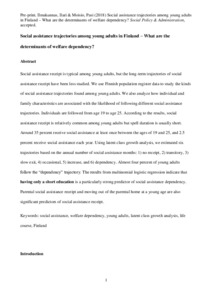Social assistance trajectories among young adults in Finland: What are the determinants of welfare dependency?
Ilmakunnas Ilari; Moisio Pasi
https://urn.fi/URN:NBN:fi-fe2021042719428
Tiivistelmä
Social assistance receipt is typical among young adults, but the long‐term trajectories of social assistance receipt have been less studied. We use Finnish population register data to study the kinds of social assistance trajectories found among young adults. We also analyze how individual and family characteristics are associated with the likelihood of following different social assistance trajectories. Individuals are followed from the age of 19 to 25. According to the results, social assistance receipt is relatively common among young adults but spell duration is usually short. Around 35% receive social assistance at least once between the ages of 19 and 25, and 2.5% receive social assistance each year. Using latent class growth analysis, we estimated six trajectories based on the annual number of social assistance months: (1) no receipt; (2) transitory; (3) slow exit; (4) occasional; (5) increase; and (6) dependency. Almost 4% of young adults follow the “dependency” trajectory. The results from multinomial logistic regression indicate that having only a short education is a particularly strong predictor of social assistance dependency. Parental social assistance receipt and moving out of the parental home at a young age are also significant predictors of social assistance receipt.
Kokoelmat
- Rinnakkaistallenteet [19207]
